VOLVO S90 2018 Owner´s Manual
Manufacturer: VOLVO, Model Year: 2018, Model line: S90, Model: VOLVO S90 2018Pages: 640, PDF Size: 11.37 MB
Page 601 of 640
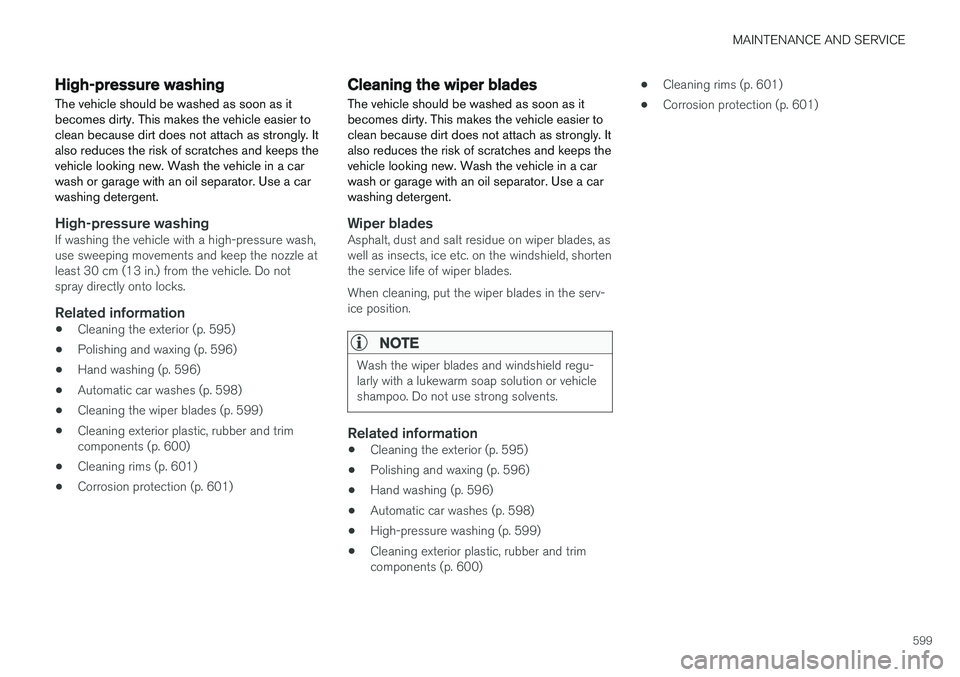
MAINTENANCE AND SERVICE
599
High-pressure washing
The vehicle should be washed as soon as it becomes dirty. This makes the vehicle easier toclean because dirt does not attach as strongly. Italso reduces the risk of scratches and keeps thevehicle looking new. Wash the vehicle in a carwash or garage with an oil separator. Use a carwashing detergent.
High-pressure washingIf washing the vehicle with a high-pressure wash, use sweeping movements and keep the nozzle atleast 30 cm (13 in.) from the vehicle. Do notspray directly onto locks.
Related information
• Cleaning the exterior (p. 595)
• Polishing and waxing (p. 596)
• Hand washing (p. 596)
• Automatic car washes (p. 598)
• Cleaning the wiper blades (p. 599)
• Cleaning exterior plastic, rubber and trimcomponents (p. 600)
• Cleaning rims (p. 601)
• Corrosion protection (p. 601)
Cleaning the wiper blades The vehicle should be washed as soon as it becomes dirty. This makes the vehicle easier toclean because dirt does not attach as strongly. Italso reduces the risk of scratches and keeps thevehicle looking new. Wash the vehicle in a carwash or garage with an oil separator. Use a carwashing detergent.
Wiper bladesAsphalt, dust and salt residue on wiper blades, as well as insects, ice etc. on the windshield, shortenthe service life of wiper blades. When cleaning, put the wiper blades in the serv- ice position.
NOTE
Wash the wiper blades and windshield regu- larly with a lukewarm soap solution or vehicleshampoo. Do not use strong solvents.
Related information
• Cleaning the exterior (p. 595)
• Polishing and waxing (p. 596)
• Hand washing (p. 596)
• Automatic car washes (p. 598)
• High-pressure washing (p. 599)
• Cleaning exterior plastic, rubber and trim components (p. 600) •
Cleaning rims (p. 601)
• Corrosion protection (p. 601)
Page 602 of 640
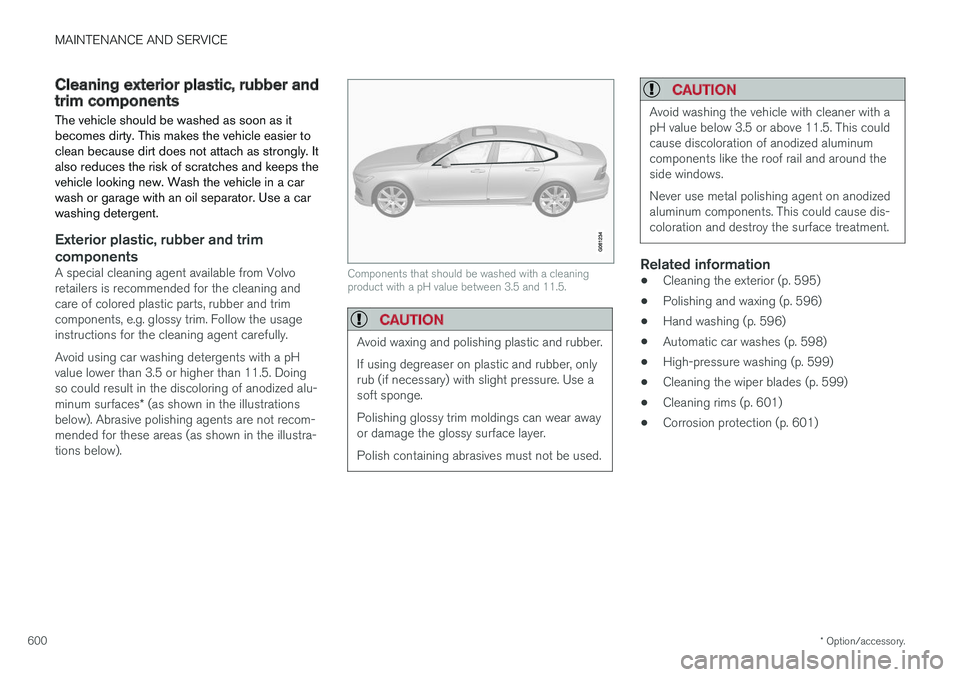
MAINTENANCE AND SERVICE
* Option/accessory.
600
Cleaning exterior plastic, rubber andtrim components The vehicle should be washed as soon as it becomes dirty. This makes the vehicle easier toclean because dirt does not attach as strongly. Italso reduces the risk of scratches and keeps thevehicle looking new. Wash the vehicle in a carwash or garage with an oil separator. Use a carwashing detergent.
Exterior plastic, rubber and trim components
A special cleaning agent available from Volvo retailers is recommended for the cleaning andcare of colored plastic parts, rubber and trimcomponents, e.g. glossy trim. Follow the usageinstructions for the cleaning agent carefully. Avoid using car washing detergents with a pH value lower than 3.5 or higher than 11.5. Doingso could result in the discoloring of anodized alu- minum surfaces * (as shown in the illustrations
below). Abrasive polishing agents are not recom- mended for these areas (as shown in the illustra-tions below).Components that should be washed with a cleaning product with a pH value between 3.5 and 11.5.
CAUTION
Avoid waxing and polishing plastic and rubber. If using degreaser on plastic and rubber, only rub (if necessary) with slight pressure. Use asoft sponge. Polishing glossy trim moldings can wear away or damage the glossy surface layer. Polish containing abrasives must not be used.
CAUTION
Avoid washing the vehicle with cleaner with a pH value below 3.5 or above 11.5. This couldcause discoloration of anodized aluminumcomponents like the roof rail and around theside windows. Never use metal polishing agent on anodized aluminum components. This could cause dis-coloration and destroy the surface treatment.
Related information
• Cleaning the exterior (p. 595)
• Polishing and waxing (p. 596)
• Hand washing (p. 596)
• Automatic car washes (p. 598)
• High-pressure washing (p. 599)
• Cleaning the wiper blades (p. 599)
• Cleaning rims (p. 601)
• Corrosion protection (p. 601)
Page 603 of 640
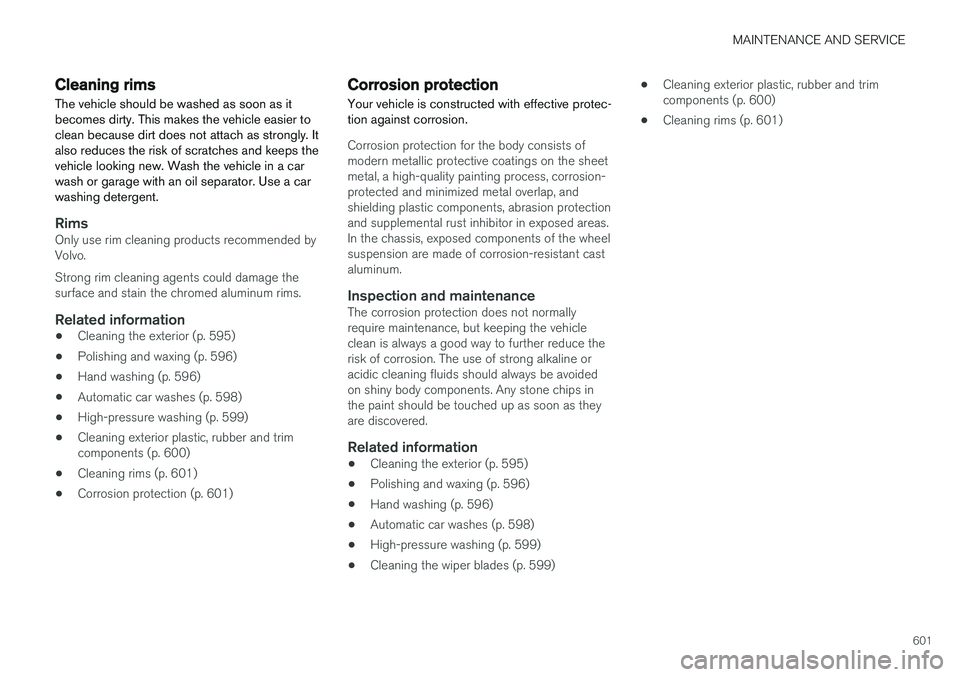
MAINTENANCE AND SERVICE
601
Cleaning rims The vehicle should be washed as soon as it becomes dirty. This makes the vehicle easier toclean because dirt does not attach as strongly. Italso reduces the risk of scratches and keeps thevehicle looking new. Wash the vehicle in a carwash or garage with an oil separator. Use a carwashing detergent.
RimsOnly use rim cleaning products recommended by Volvo. Strong rim cleaning agents could damage the surface and stain the chromed aluminum rims.
Related information
•Cleaning the exterior (p. 595)
• Polishing and waxing (p. 596)
• Hand washing (p. 596)
• Automatic car washes (p. 598)
• High-pressure washing (p. 599)
• Cleaning exterior plastic, rubber and trimcomponents (p. 600)
• Cleaning rims (p. 601)
• Corrosion protection (p. 601)
Corrosion protection
Your vehicle is constructed with effective protec- tion against corrosion.
Corrosion protection for the body consists of modern metallic protective coatings on the sheetmetal, a high-quality painting process, corrosion-protected and minimized metal overlap, andshielding plastic components, abrasion protectionand supplemental rust inhibitor in exposed areas.In the chassis, exposed components of the wheelsuspension are made of corrosion-resistant castaluminum.
Inspection and maintenanceThe corrosion protection does not normallyrequire maintenance, but keeping the vehicleclean is always a good way to further reduce therisk of corrosion. The use of strong alkaline oracidic cleaning fluids should always be avoidedon shiny body components. Any stone chips inthe paint should be touched up as soon as theyare discovered.
Related information
• Cleaning the exterior (p. 595)
• Polishing and waxing (p. 596)
• Hand washing (p. 596)
• Automatic car washes (p. 598)
• High-pressure washing (p. 599)
• Cleaning the wiper blades (p. 599) •
Cleaning exterior plastic, rubber and trimcomponents (p. 600)
• Cleaning rims (p. 601)
Page 604 of 640
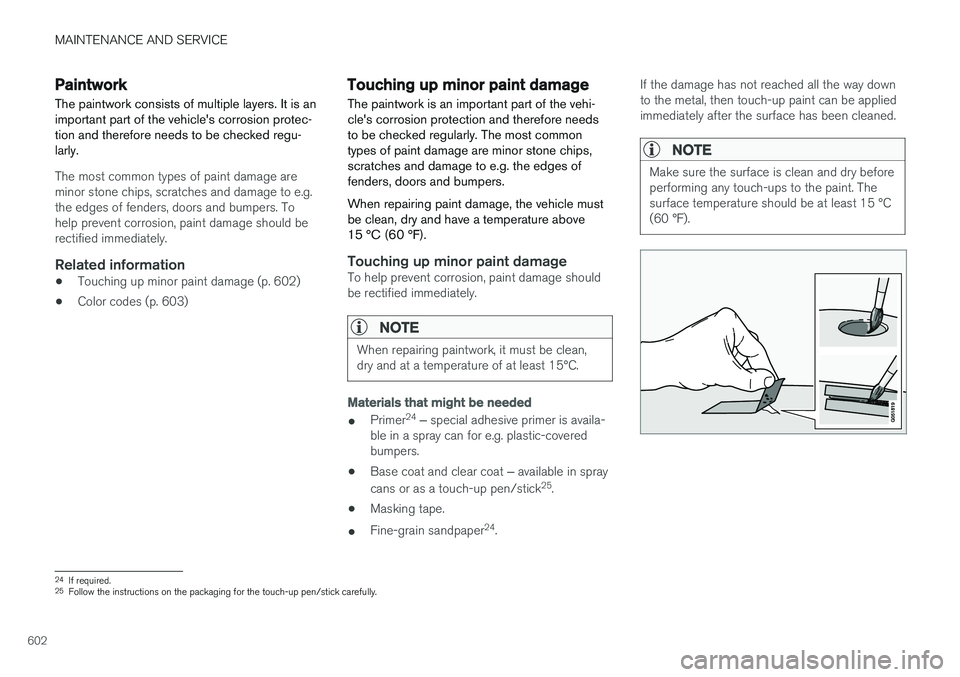
MAINTENANCE AND SERVICE
602
Paintwork
The paintwork consists of multiple layers. It is an important part of the vehicle's corrosion protec-tion and therefore needs to be checked regu-larly.
The most common types of paint damage are minor stone chips, scratches and damage to e.g.the edges of fenders, doors and bumpers. Tohelp prevent corrosion, paint damage should berectified immediately.
Related information
• Touching up minor paint damage (p. 602)
• Color codes (p. 603)
Touching up minor paint damage
The paintwork is an important part of the vehi- cle's corrosion protection and therefore needsto be checked regularly. The most commontypes of paint damage are minor stone chips,scratches and damage to e.g. the edges offenders, doors and bumpers. When repairing paint damage, the vehicle must be clean, dry and have a temperature above15 °C (60 °F).
Touching up minor paint damageTo help prevent corrosion, paint damage should be rectified immediately.
NOTE
When repairing paintwork, it must be clean, dry and at a temperature of at least 15°C.
Materials that might be needed
• Primer 24
‒
special adhesive primer is availa-
ble in a spray can for e.g. plastic-covered bumpers.
• Base coat and clear coat
‒ available in spray
cans or as a touch-up pen/stick 25
.
• Masking tape.
• Fine-grain sandpaper 24
. If the damage has not reached all the way downto the metal, then touch-up paint can be appliedimmediately after the surface has been cleaned.
NOTE
Make sure the surface is clean and dry before performing any touch-ups to the paint. Thesurface temperature should be at least 15 °C(60 °F).
24
If required.
25 Follow the instructions on the packaging for the touch-up pen/stick carefully.
Page 605 of 640
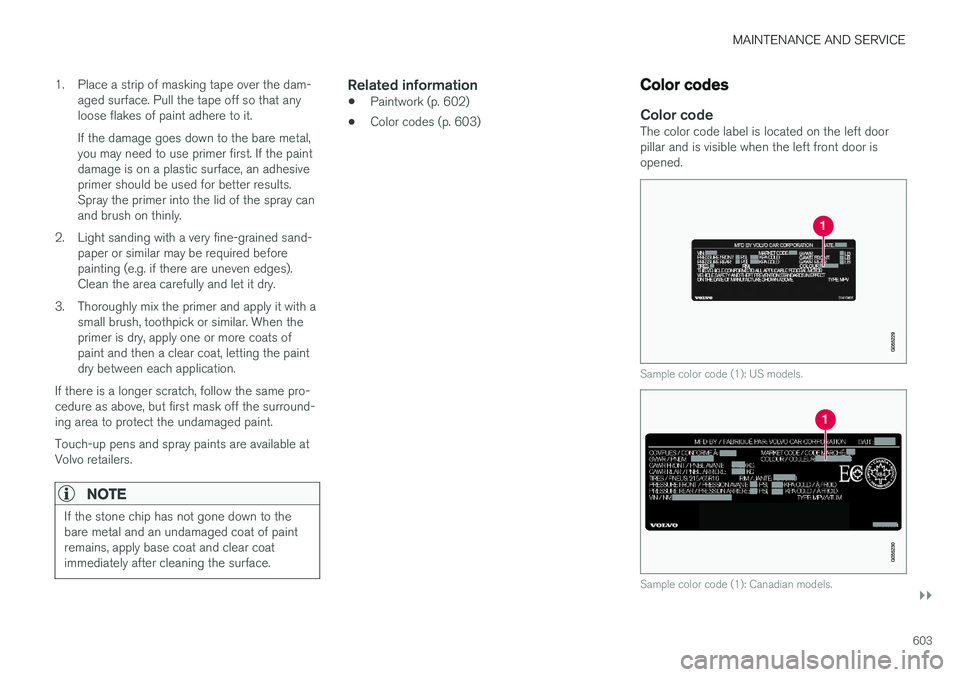
MAINTENANCE AND SERVICE
}}
603
1. Place a strip of masking tape over the dam-
aged surface. Pull the tape off so that any loose flakes of paint adhere to it. If the damage goes down to the bare metal, you may need to use primer first. If the paintdamage is on a plastic surface, an adhesiveprimer should be used for better results.Spray the primer into the lid of the spray canand brush on thinly.
2. Light sanding with a very fine-grained sand- paper or similar may be required beforepainting (e.g. if there are uneven edges).Clean the area carefully and let it dry.
3. Thoroughly mix the primer and apply it with a small brush, toothpick or similar. When theprimer is dry, apply one or more coats ofpaint and then a clear coat, letting the paintdry between each application.
If there is a longer scratch, follow the same pro-cedure as above, but first mask off the surround-ing area to protect the undamaged paint. Touch-up pens and spray paints are available at Volvo retailers.
NOTE
If the stone chip has not gone down to the bare metal and an undamaged coat of paintremains, apply base coat and clear coatimmediately after cleaning the surface.
Related information
• Paintwork (p. 602)
• Color codes (p. 603)
Color codes
Color codeThe color code label is located on the left door pillar and is visible when the left front door isopened.
Sample color code (1): US models.
Sample color code (1): Canadian models.
Page 606 of 640
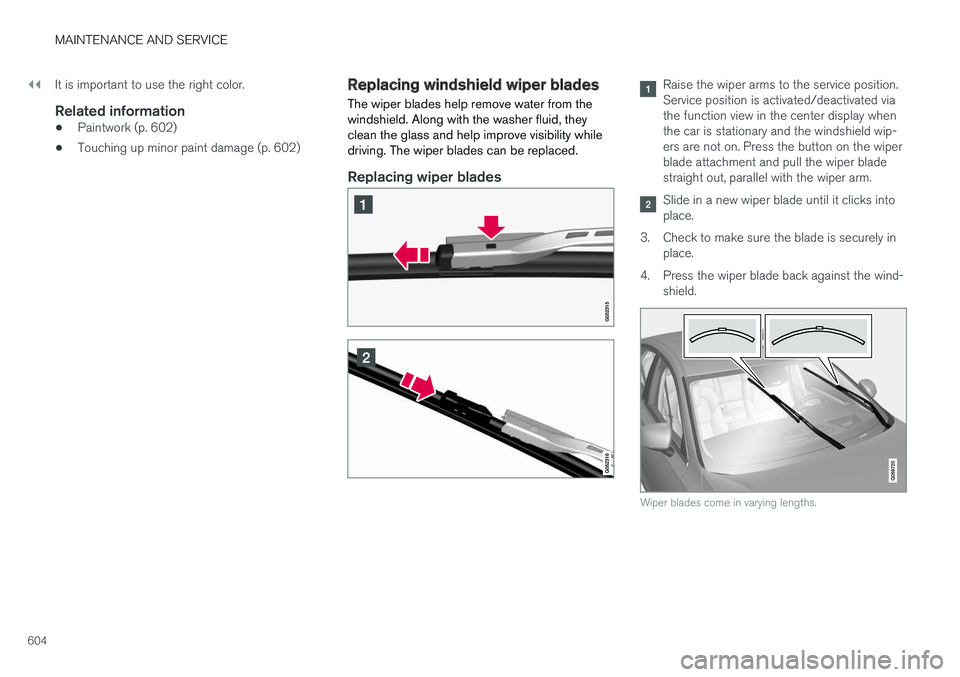
||
MAINTENANCE AND SERVICE
604It is important to use the right color.
Related information
•
Paintwork (p. 602)
• Touching up minor paint damage (p. 602)
Replacing windshield wiper blades
The wiper blades help remove water from the windshield. Along with the washer fluid, theyclean the glass and help improve visibility whiledriving. The wiper blades can be replaced.
Replacing wiper blades
Raise the wiper arms to the service position. Service position is activated/deactivated viathe function view in the center display whenthe car is stationary and the windshield wip-ers are not on. Press the button on the wiperblade attachment and pull the wiper bladestraight out, parallel with the wiper arm.
Slide in a new wiper blade until it clicks into place.
3. Check to make sure the blade is securely in place.
4. Press the wiper blade back against the wind- shield.
Wiper blades come in varying lengths.
Page 607 of 640
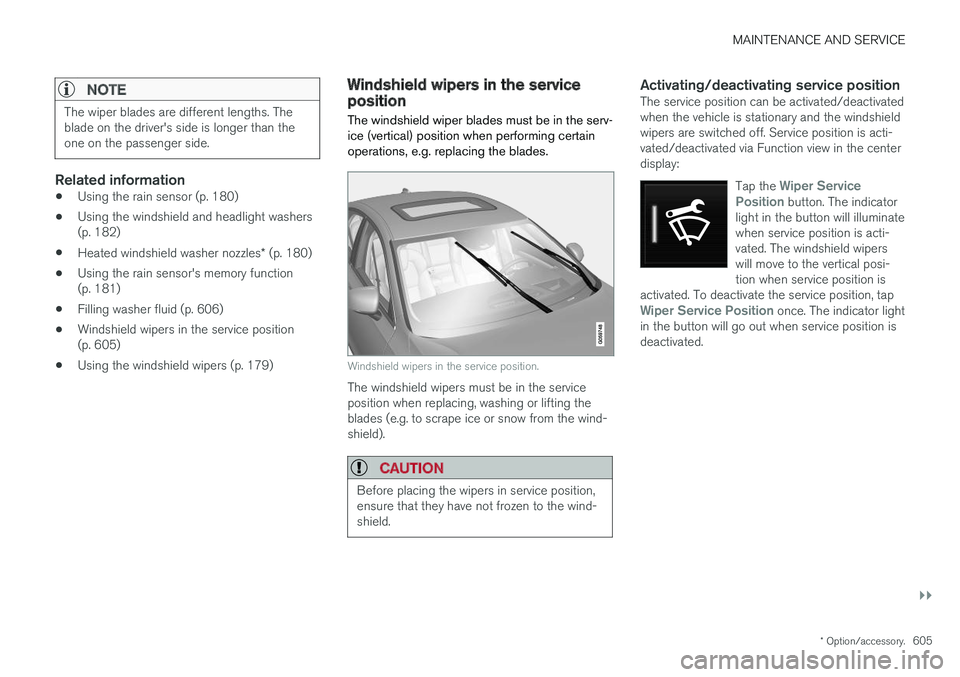
MAINTENANCE AND SERVICE
}}
* Option/accessory.605
NOTE
The wiper blades are different lengths. The blade on the driver's side is longer than theone on the passenger side.
Related information
•Using the rain sensor (p. 180)
• Using the windshield and headlight washers (p. 182)
• Heated windshield washer nozzles
* (p. 180)
• Using the rain sensor's memory function(p. 181)
• Filling washer fluid (p. 606)
• Windshield wipers in the service position(p. 605)
• Using the windshield wipers (p. 179)
Windshield wipers in the serviceposition
The windshield wiper blades must be in the serv- ice (vertical) position when performing certainoperations, e.g. replacing the blades.
Windshield wipers in the service position.
The windshield wipers must be in the service position when replacing, washing or lifting theblades (e.g. to scrape ice or snow from the wind-shield).
CAUTION
Before placing the wipers in service position, ensure that they have not frozen to the wind-shield.
Activating/deactivating service positionThe service position can be activated/deactivated when the vehicle is stationary and the windshieldwipers are switched off. Service position is acti-vated/deactivated via Function view in the centerdisplay:
Tap the
Wiper Service
Position button. The indicator
light in the button will illuminate when service position is acti-vated. The windshield wiperswill move to the vertical posi-tion when service position is
activated. To deactivate the service position, tap
Wiper Service Position once. The indicator light
in the button will go out when service position is deactivated.
Page 608 of 640
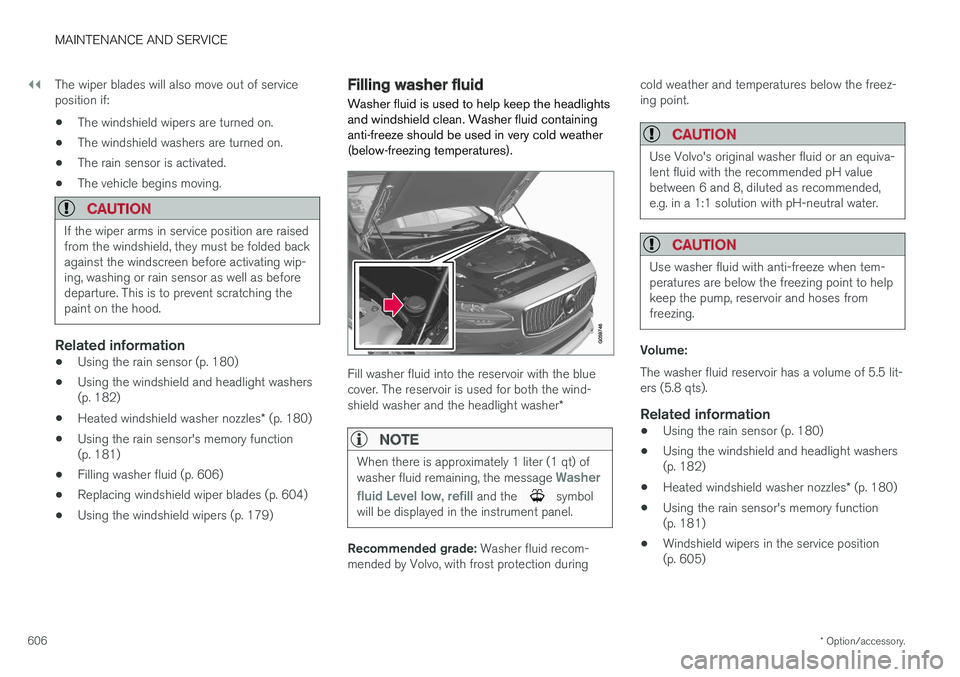
||
MAINTENANCE AND SERVICE
* Option/accessory.
606 The wiper blades will also move out of service position if:
• The windshield wipers are turned on.
• The windshield washers are turned on.
• The rain sensor is activated.
• The vehicle begins moving.
CAUTION
If the wiper arms in service position are raised from the windshield, they must be folded backagainst the windscreen before activating wip-ing, washing or rain sensor as well as beforedeparture. This is to prevent scratching thepaint on the hood.
Related information
• Using the rain sensor (p. 180)
• Using the windshield and headlight washers (p. 182)
• Heated windshield washer nozzles
* (p. 180)
• Using the rain sensor's memory function(p. 181)
• Filling washer fluid (p. 606)
• Replacing windshield wiper blades (p. 604)
• Using the windshield wipers (p. 179)
Filling washer fluid
Washer fluid is used to help keep the headlights and windshield clean. Washer fluid containinganti-freeze should be used in very cold weather(below-freezing temperatures).
Fill washer fluid into the reservoir with the blue cover. The reservoir is used for both the wind- shield washer and the headlight washer *
NOTE
When there is approximately 1 liter (1 qt) of washer fluid remaining, the message Washer
fluid
Level low, refill and the symbol
will be displayed in the instrument panel.
Recommended grade: Washer fluid recom-
mended by Volvo, with frost protection during cold weather and temperatures below the freez- ing point.
CAUTION
Use Volvo's original washer fluid or an equiva- lent fluid with the recommended pH valuebetween 6 and 8, diluted as recommended,e.g. in a 1:1 solution with pH-neutral water.
CAUTION
Use washer fluid with anti-freeze when tem- peratures are below the freezing point to helpkeep the pump, reservoir and hoses fromfreezing.
Volume: The washer fluid reservoir has a volume of 5.5 lit- ers (5.8 qts).
Related information
•
Using the rain sensor (p. 180)
• Using the windshield and headlight washers(p. 182)
• Heated windshield washer nozzles
* (p. 180)
• Using the rain sensor's memory function(p. 181)
• Windshield wipers in the service position(p. 605)
Page 609 of 640
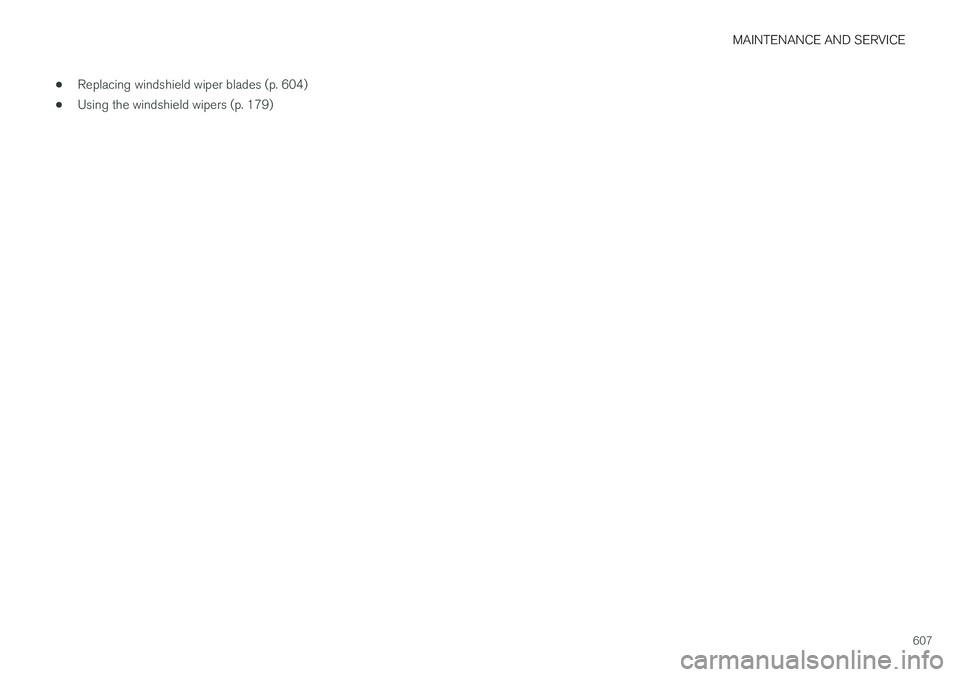
MAINTENANCE AND SERVICE
607
•
Replacing windshield wiper blades (p. 604)
• Using the windshield wipers (p. 179)
Page 610 of 640
